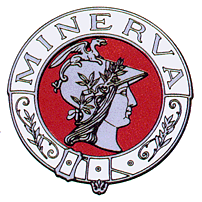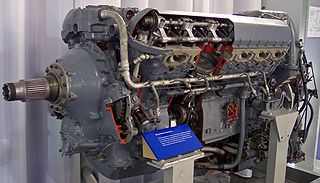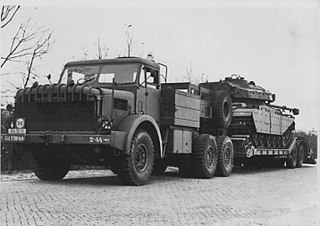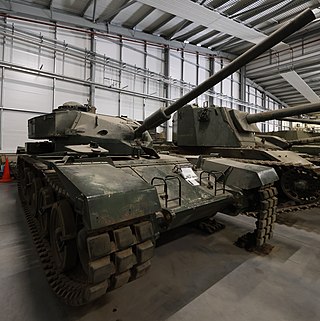
The Rolls-Royce Merlin is a British liquid-cooled V-12 piston aero engine of 27-litre capacity. Rolls-Royce designed the engine and first ran it in 1933 as a private venture. Initially known as the PV-12, it was later called Merlin following the company convention of naming its four-stroke piston aero engines after birds of prey. The engine benefitted from the racing experiences of precursor engines in the 1930s.

The Centurion was the primary British Army main battle tank of the post-World War II period. Introduced in 1945, it is widely considered to be one of the most successful post-war tank designs, remaining in production into the 1960s, and seeing combat into the 1980s. The chassis was adapted for several other roles, and these variants have remained in service. It was a very popular tank with good armour, mobility, and a powerful main armament.

The Cromwell tank, officially Tank, Cruiser, Mk VIII, Cromwell (A27M), was one of the series of cruiser tanks fielded by Britain in the Second World War. Named after the English Civil War-era military leader Oliver Cromwell, the Cromwell was the first tank put into service by the British to combine high speed from a powerful, reliable engine and reasonable armour. The intended dual-purpose high velocity gun could not be fitted in the turret, so a medium velocity dual purpose gun was fitted instead. Further development of the Cromwell combined with a high velocity gun led to the Comet tank.

Minerva was a Belgian firm active from 1902 to 1938 and a manufacturer of luxury automobiles. The company became defunct in 1956.

The Volkswagen XL1 is a two-person limited production diesel-powered plug-in hybrid produced by Volkswagen. The XL1 car was designed to be able to travel 100 km on 1 litre of diesel, while being both roadworthy and practical. To achieve such economy, it was produced with lightweight materials, a streamlined body and an engine and transmission designed and tuned for economy. The concept car was modified first in 2009 as the L1 and again in 2011 as the XL1.

The FV4201 Chieftain was the main battle tank (MBT) of the United Kingdom from the 1960s into 1990s. When introduced, it was among the most heavily armed MBTs of the era, mounting a 120 mm Royal Ordnance L11 gun, the equal of the much larger specialist heavy tanks then in service. It also was among the most heavily armoured, with up to 195 mm (7.7 in) that was highly sloped to offer 388 mm (15.3 in) thickness along the line of sight.

The FV 214 Conqueror, also known as Tank, Heavy No. 1, 120 mm Gun, Conqueror was a British heavy tank of the post-World War II era. It was developed as a response to the Soviet IS-3 heavy tank. The Conqueror's main armament, an L1 120 mm gun, was larger than the 20-pounder (83.4 mm) gun carried by its peer, the Centurion. The Conqueror's role was to provide long range anti-tank support for the Centurion. Nine Conquerors were issued for each regiment in Germany, usually grouped in three tank troops. In the British Army both the Conqueror and the Centurion were replaced by the Chieftain.

The Rolls-Royce Griffon is a British 37-litre capacity, 60-degree V-12, liquid-cooled aero engine designed and built by Rolls-Royce Limited. In keeping with company convention, the Griffon was named after a bird of prey, in this case the griffon vulture.

The Mighty Antar was a heavy-duty 6×4 tractor unit built by Thornycroft from the late 1940s onwards. For some decades it was the standard tank transporter of the British Army and was also used by other nations. It was powered by a shortened V8 land version of the V12 Meteor engine, derived from the Merlin and modified to run on diesel, known as the Rolls-Royce Meteorite.

An armoured recovery vehicle (ARV) is typically a powerful tank or armoured personnel carrier (APC) chassis modified for use during combat for military vehicle recovery (towing) or repair of battle-damaged, stuck, and/or inoperable armoured fighting vehicles, such as tanks and armoured personnel carriers. Most ARVs have motorized tracks, like a tank or bulldozer, enabling the ARV to operate on uneven ground. The term "Armoured Repair and Recovery Vehicle" (ARRV) is also used.

The Light Tank Mark I to Mark V were a series of related designs of light tank produced by Vickers for the British Army during the interwar period.

The Rolls-Royce Meteorite, also known as the Rover Meteorite, was a post-war British 18.01 L (1,099 cu in) V8 petrol or diesel engine was derived from the Rolls-Royce Meteor tank engine.

The M35 2½-ton cargo truck is a long-lived 2½-ton 6×6 cargo truck initially used by the United States Army and subsequently utilized by many nations around the world. Over time it evolved into a family of specialized vehicles. It inherited the nickname "Deuce and a Half" from an older 2½-ton truck, the World War II GMC CCKW.

The OF-40 is an Italian main battle tank developed as a joint venture between OTO Melara and Fiat, and intended primarily for export sales. OTO Melara would develop and produce the hulls, and automotive components would be provided by Fiat. Initial design work was started by OTO Melara in 1977, with the first prototypes ready by 1980.

The Entpannungspanzer 65 is a Swiss armored recovery vehicle developed by Eidgenoessische Konstruktionswerkstaette Thun in the late 1960s. The vehicle served as a traveling workshop for the Swiss military.

The Rotinoff Super Atlantic is a 6×4 ballast tractor made by the British company Rotinoff Motors Ltd. The tractor was designed for GCW of 200 tons with the help of a Rolls-Royce six cylinder supercharged engine producing almost 335 bhp with support of six speed main gearbox and a three speed auxiliary box for critical conditions. Kirkstall axles were used due to heavy operations of the tractor which had tire size of 18.00-25 and 14.0024 as optional to bring the vehicle to still it was equipped with compressed air brakes the drum measured 19 by 4 and 19 by 7 front and rear respectively.

The Rolls-Royce B range was a range of petrol engines first intended to be installed in a car but in 1943 developed into a range to power the British Army's wheeled vehicles.

The Leyland L60 was a British 19-litre (1,200 cu in) vertical six-cylinder opposed-piston two-stroke multi-fuel diesel engine designed by Leyland Motors in the late 1950s/early 1960s for the Chieftain main battle tank (MBT). The engine was also used in the Vickers MBT and its Indian-built derivative, the Vijayanta.

The Vickers Main Battle Tank Mk. 3 is a main battle tank by Vickers, a development of the Vickers MBT, and introduced in 1975 for the export market. It was the last of the Vickers tanks to see sales in numbers abroad.

The Tank Medium No. 2 Experimental Vehicle FV4202 also known as the 40-ton Centurion was a technology test bed developed by British company Leyland Motors between 1955 and 1956. It was used to develop various concepts later used in the Chieftain main battle tank.



















